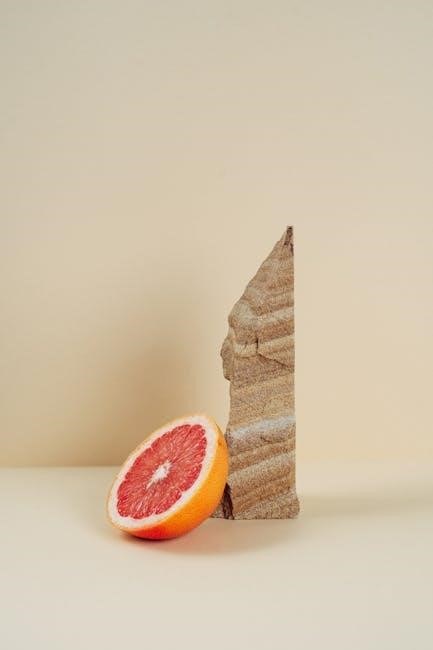brownie shapes in nature badge requirements pdf

The Brownie Shapes in Nature Badge is an engaging way for young Girl Scouts to explore the natural world while learning about patterns, symmetry, and creativity․ This badge encourages girls to observe their surroundings, identify shapes in nature, and express their findings through art and data collection․ The program is designed to foster curiosity, teamwork, and an appreciation for the environment․
Key activities include scavenger hunts to identify shapes like circles, squares, and spirals in nature, creating art inspired by natural patterns, and learning about concepts such as symmetry and tessellations․ Girls also practice observation skills by tracking natural objects and using tally marks to record data․ The badge emphasizes hands-on learning, making it both fun and educational․ By earning this badge, Brownies gain a deeper understanding of how shapes and patterns appear in nature and how they can be used creatively․ The Shapes in Nature Badge is a great way to connect science, art, and outdoor exploration, providing girls with lasting skills and memories․
Overview of the Brownie Shapes in Nature Badge
Overview of the Brownie Shapes in Nature Badge
The Brownie Shapes in Nature Badge is a thoughtfully designed program by Girl Scouts of the USA (GSUSA) to help young girls explore and appreciate the natural world through the lens of shapes, patterns, and creativity․ Released in 2021, this badge is part of a series that includes Shapes in Nature and Numbers in Nature, but it can be earned independently, allowing troops to focus on the aspects that most interest them․ The badge is structured to encourage girls to observe their surroundings, identify shapes and patterns in nature, and express their findings through art, data collection, and creative projects․
The program is divided into five key steps, each designed to build skills and knowledge while fostering a deeper connection with the environment․ The first step involves tracking natural objects, where girls learn to observe and categorize items they find in nature․ This activity introduces them to the concept of classification and helps them develop their observational skills․ For example, girls might categorize objects as natural or man-made, living or non-living, or group them by type, such as different kinds of leaves or rocks․

The second step focuses on graphing natural objects, where girls learn to represent their findings visually․ Using tally marks and simple graphs, they practice recording and interpreting data․ This step not only reinforces math skills but also encourages girls to think about patterns and frequencies in nature․ For instance, they might count the number of birds they see in a park or the types of flowers that grow in a specific area․
In the third step, girls explore symmetry in nature by creating a spiderweb with symmetry․ This activity introduces them to the concept of bilateral symmetry, where one half of an object is a mirror image of the other․ Girls might also learn about circular symmetry by creating art inspired by natural patterns, such as the concentric circles found in tree trunks or the spiral shapes of seashells․ These projects help girls understand how symmetry appears in nature and how it can be used in art and design․
The fourth step delves into tessellations, which are repeating patterns of shapes that fit together without overlapping․ Girls might create their own tessellation patterns or explore how tessellations appear in nature, such as in the hexagonal cells of a honeycomb or the scales of a fish․ This step encourages creativity and an understanding of how shapes can be used to create larger, cohesive designs․
Finally, the fifth step involves collecting data about birds․ Girls might go on a bird-watching excursion, using apps like iNaturalist to identify species and tally the number of birds they see․ This activity teaches them about the diversity of bird life and the importance of observation in scientific research․
The Brownie Shapes in Nature Badge is supported by a variety of resources, including activity plans in the GSUSA Volunteer Toolkit (VTK) and optional workbooks that guide girls through each step․ Troop leaders can adapt these resources to suit the needs and interests of their group, ensuring that the activities are both fun and educational․ For example, girls who enjoy art might particularly enjoy the projects that involve drawing or crafting, while those who prefer science might find the data collection and graphing steps more engaging․
One of the unique aspects of this badge is its emphasis on outdoor exploration․ Girls are encouraged to spend time in nature, whether it’s a local park, a garden, or even their own backyard․ By doing so, they gain a greater appreciation for the natural world and develop a sense of stewardship․ The badge also fosters teamwork, as girls often work together on activities like scavenger hunts or group art projects․
The Brownie Shapes in Nature Badge is a valuable addition to the Girl Scout curriculum, offering girls the opportunity to learn about science, art, and the environment in a hands-on and engaging way․ By earning this badge, girls not only gain new skills and knowledge but also develop a lifelong love of nature and a creative way of seeing the world․
Importance of Observing Nature
Importance of Observing Nature
Observing nature is a fundamental aspect of the Brownie Shapes in Nature Badge, as it encourages girls to develop a deeper connection with the world around them․ By exploring and studying nature, girls can gain essential skills such as observation, critical thinking, and creativity․ This badge emphasizes the importance of slowing down, paying attention to details, and appreciating the beauty and complexity of the natural world․
One of the key benefits of observing nature is the development of scientific skills․ Girls learn to identify patterns, shapes, and symmetry in natural objects, such as leaves, flowers, and rocks․ These observations help them understand basic scientific concepts, such as the Fibonacci sequence and tessellations, which often appear in nature․ For example, the arrangement of seeds in a sunflower or the branches of a tree can demonstrate these mathematical patterns․ By recognizing these patterns, girls can develop a stronger understanding of how math and science are present in the world around them․
In addition to scientific skills, observing nature fosters creativity and artistry․ The Brownie Shapes in Nature Badge encourages girls to create art inspired by natural patterns, such as circular symmetry in tree trunks or spiral shapes in seashells․ These creative projects help girls express their observations in a meaningful way and see the world as a source of inspiration․ For instance, girls might draw concentric circles to represent the layers of a tree or use natural materials like leaves and sticks to create collages․ This connection between nature and art helps girls develop their imagination and appreciation for the environment․
Another important aspect of observing nature is the development of environmental stewardship․ By spending time outdoors and studying natural objects, girls gain a greater appreciation for the interconnectedness of all living things․ This awareness can inspire them to take action to protect the environment, whether through recycling, planting trees, or reducing waste․ The badge also encourages girls to think critically about the impact of human activities on nature, fostering a sense of responsibility and care for the planet․
Observing nature also promotes physical and mental well-being․ Spending time outdoors has been shown to reduce stress, improve mood, and enhance overall health․ For girls, exploring nature provides an opportunity to disconnect from screens and engage in hands-on, active learning․ Activities such as scavenger hunts, bird-watching, and nature walks encourage physical activity while also fostering mindfulness and relaxation․ By immersing themselves in nature, girls can develop a sense of calm and a deeper appreciation for the world around them․
Furthermore, observing nature helps girls develop teamwork and collaboration skills․ Many of the activities associated with the Brownie Shapes in Nature Badge require girls to work together, whether they are tracking natural objects, creating group art projects, or collecting data about birds․ These collaborative efforts encourage girls to share ideas, listen to one another, and build on each other’s strengths․ For example, during a scavenger hunt, girls might divide tasks such as identifying shapes, recording observations, and tallying results․ This teamwork not only enhances their learning experience but also strengthens their friendships and communication skills․
The process of observing nature also teaches girls the value of patience and persistence․ Identifying shapes and patterns in nature can be a challenging but rewarding experience․ Girls may need to spend time searching for specific examples, such as fractals in tree branches or bilateral symmetry in leaves․ This process helps them develop a growth mindset, understanding that some tasks require effort and dedication․ Additionally, the sense of accomplishment they feel when they successfully identify a shape or complete a project reinforces the importance of perseverance and hard work․
Key Concepts and Skills
Key Concepts and Skills

The Brownie Shapes in Nature Badge is designed to introduce girls to a variety of key concepts and skills that combine science, art, and outdoor exploration․ This badge focuses on helping girls recognize and understand the shapes, patterns, and mathematical concepts found in nature․ By completing the activities outlined in the badge requirements, girls will gain a deeper understanding of the natural world and develop essential skills in observation, creativity, and critical thinking․
One of the primary concepts explored in this badge is symmetry․ Symmetry refers to the quality of being made up of parts that are mirror images of each other or that can be rotated to match․ Girls will learn to identify different types of symmetry in nature, such as bilateral symmetry (where one half is a mirror image of the other, like a butterfly’s wings) and circular symmetry (where patterns repeat around a central point, like the layers of a tree trunk)․ Activities such as folding paper to create snowflakes with six lines of symmetry or tracing a partner’s body to demonstrate bilateral symmetry help girls visualize and understand these concepts․
Another important concept is fractals, which are self-repeating patterns that appear at different scales․ Examples of fractals in nature include the branching of trees, the flow of rivers, and the structure of Romanesco broccoli․ By exploring fractals, girls learn to recognize how these patterns repeat and how they contribute to the complexity and beauty of natural objects․ Activities such as scavenger hunts to find fractals in nature or creating art inspired by fractal patterns help reinforce this concept․
The Fibonacci sequence is another key mathematical concept introduced in this badge․ The Fibonacci sequence is a series of numbers in which each number is the sum of the two preceding ones (1, 1, 2, 3, 5, 8, 13, etc․)․ This sequence often appears in nature, such as in the arrangement of seeds in a sunflower, the branches of trees, or the spiral of a nautilus shell․ Girls will learn to identify and explore these patterns, gaining an understanding of how math is present in the natural world․

In addition to these concepts, girls will develop important skills through the activities outlined in the badge requirements․ One of the most critical skills is observation․ Girls will learn to carefully observe and record natural objects, such as leaves, flowers, and birds, using tools like tally marks and graphs to document their findings․ This skill helps girls develop their attention to detail and ability to analyze the world around them․
Another key skill is creativity․ The badge encourages girls to express their observations through art projects, such as creating nature-inspired collages, drawing concentric circles to represent tree layers, or designing tessellations (repeating patterns) using natural shapes․ These activities help girls see nature as a source of inspiration and develop their artistic skills while connecting with the environment․
Girls will also gain experience with data collection and graphing․ By tracking natural objects, such as the number of birds observed or the types of leaves collected, girls learn to organize and interpret data․ This introduces them to basic scientific methods and helps them understand how data can be used to tell stories about the natural world․
The badge also emphasizes the development of problem-solving skills․ Activities such as creating art with circular symmetry or designing tessellations require girls to think critically and experiment with different approaches․ These challenges help girls build confidence in their ability to tackle problems and try new things․

Teamwork and collaboration are additional skills fostered through this badge․ Many activities, such as scavenger hunts or group art projects, require girls to work together, share ideas, and build on each other’s strengths․ This collaborative approach not only enhances their learning experience but also strengthens their communication and interpersonal skills․

Finally, the Brownie Shapes in Nature Badge helps girls develop a greater appreciation for nature․ By spending time outdoors, observing natural objects, and learning about the patterns and shapes that appear in nature, girls gain a deeper understanding of the interconnectedness of the world around them; This fosters a sense of environmental stewardship and encourages girls to take action to protect and preserve the natural world․